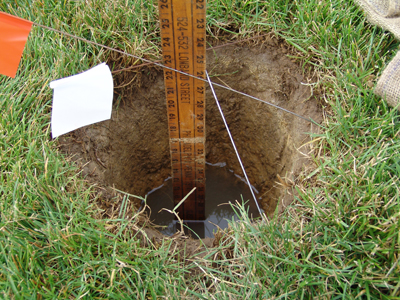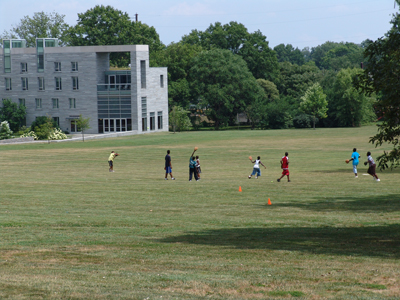Organic Lawn Care
In the fall 2009, a New York Times article about an innovative organic lawn care project at Harvard University shook the assumptions of other higher education institutions regarding their own landscaping practices. A casual inquiry about Swarthmore’s lawn management by an alumnus who had read the piece sparked a flurry of discussion and activity that will culminate this fall in the implementation of the Scott Arboretum’s first organically maintained lawn.
Instead of applying standard synthetic herbicides and fertilizers to the five-acre field between Mertz dormitory and Magill Walk, gardeners will spread compost and spray compost tea. This organic matter will be carefully prepared and monitored to contain a balance of nutrients that fully nourish the soil, the microorganisms that dwell within it and, in turn, the grass. We currently use organic fertilizers and practice integrated pest management as a part of sustainability efforts. This summer we will begin testing organic lawn practices.
Based on favorable results at Harvard, we hope that our new lawn will improve the health of the turf and local ecosystem, minimize environmental impact by reducing mowing and irrigation needs, and offer a cost-saving alternative to conventional lawn care. Since the new approach requires closer monitoring and ongoing program adjustments, labor costs will rise; the cost of purchased supplies, however, will decrease. A project on a New York football field showed that once established, organic lawns can be 25% less expensive to maintain!

“A comparison of costs (dollars) for conventional and natural turf programs over a five-year period, based on data collected and analyzed by Charles Osborne and Doug Wood, Grassroots Environmental Education 2010.”
Next month, Eric T. Fleisher, the coordinator of Harvard’s organic turf program, will visit our campus to tailor his compost tea recipes, application schedules, and aeration techniques to the specific needs of our site.
A rising sophomore and student liaison to the Sustainability Committee this past spring, I received a grant from the Lang Center to work on the lawn care project with Grounds and the Arboretum. My first task was to run the diagnostic tests identifying the present makeup of the soil and turf upon which T. Fleisher will base his recommendations. Using the procedures that he prescribed, I have spent the past few weeks preparing soil samples for lab analysis and conducting percolation tests to determine the rate at which the soil is able to absorb water.
We have to wait for the UMass Amherst Soil Testing Laboratory to get back to us to learn the concentrations of organic matter and extractable nutrients, the soil texture, and the level of soluble salts in the soil, but the percolation tests returned immediate results.

Satellite image of Mertz field taken in 2008 during the construction of David Kemp Residence Hall. photo credit: Google Maps
To account for potential differences among the rates at which water infiltrates into the soil at different depths, I dug three foot-wide holes 6”, 12”, and 18” deep respectively. I then roughed the edges of each hole (so that water enters the soil as “naturally” as possible), lined the bottoms with sand (minimizing splashing, also a potentially confounding factor), and saturated the soil to control for dryness (making tests run the day after a rain comparable to those done in the middle of a drought). After completing these preparations, I filled the holes with water and checked them frequently over the next 12 hours, recording the height of the water column. Noting how quickly the water level drops allows us to infer the porosity of the soil—a more porous soil provides many channels for water, organisms, and roots to pass—an important factor in stormwater retention and turf health.
A healthy lawn percolates at one to two inches per hour. I conducted the three-hole test in each of three distinct zones of Mertz lawn; only the moist lowermost region drained this quickly. Since the second zone was subject to severe compaction by heavy machinery during the construction of the David Kemp Residence Hall in 2008, percolation rates were especially low there. Water infiltrated at only half an inch per hour. The upper zone, everything uphill of the old laydown area, exhibited intermediate characteristics.
I noticed other differences between the soils in each zone simply by feeling how hard it was to dig (the rocky Middle Mertz required a pickaxe), the general consistency and moistness (Upper Mertz was damper than Middle Mertz but drier than Lower Mertz), and the number and kinds of organisms I came across in the soil (so many earthworms in Lower Mertz!).
Understanding what creates a healthy soil ecosystem is the key to cultivating a thriving green lawn. The results of our diagnostic tests and observations will allow us to design an organic lawn care program that continues our tradition as “the most beautiful campus in the United States.”
Our motivation behind this non-conventional approach lies in the bigger picture—fostering the health of the Crum Creek watershed and its human inhabitants. The college and Arboretum have always strived to be responsible stewards of both by following conventional best practices. But as Rachel Carson taught us, the unintended consequences of one decade’s practices may not become apparent until the next—some health effects of the chemicals we apply could take generations to become apparent, for example. Repercussions of our dependence on petroleum-based products will be magnified when the energy crisis truly sets in. In order to keep our community and environment healthy and sustainable, therefore, we are excited to push forward to tomorrow’s innovation: organic lawns! Check back with Garden Seeds as we describe our progress in developing an organic lawn maintenance program.









Mill Nash
Posted at 08:29h, 01 JulyFantastic and Congratulations!
Camille come work for me in San Francisco after college!
http://www.cleanairlawncare.com
Roxanne
Posted at 08:46h, 01 JulyCamille:
Nicely written and informative article. I look forward to more.
Camille Robertson '13
Posted at 07:03h, 02 JulyThanks, Roxanne. This post will be the first of many!
Mill, the fact sheets comparing electric and gas mowing practices on your website are fantastic. While we will continue employing the same (gas-powered) landscaping company to mow our lawn, by going organic, Harvard was able to reduce its mowing frequency by 50%. This change was possible because unlike synthetic fertilizers that stimulate sudden and extraneous grass blade growth, nutrients in organic matter like compost and compost tea become available for plant uptake more gradually, fostering steady, continuous root growth. We hope that our organically revitalized lawn at Swarthmore will similarly require less mowing, reducing associated fossil fuel consumption and air pollution!
Sue Stark
Posted at 12:54h, 04 JulyAmong all of the other environmental benefits, how great it will be to see the kids playing on an organically maintained field!
Hudson Valley Organic Lawn Services
Posted at 15:51h, 23 AugustInteresting statement about organic lawns being “tomorrow’s innovation.” A healthy field sounds like something everybody could enjoy.